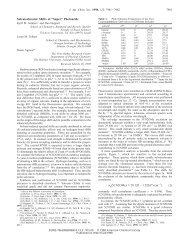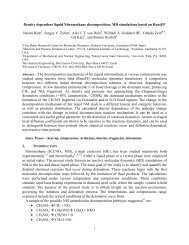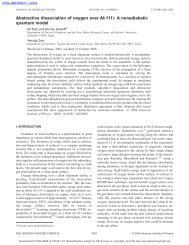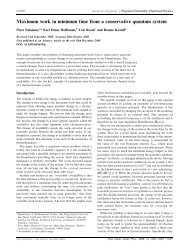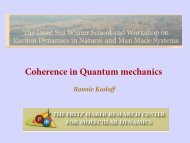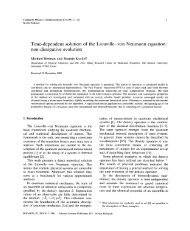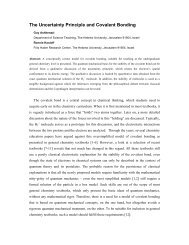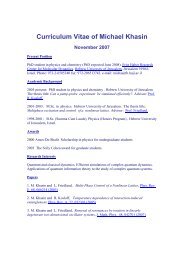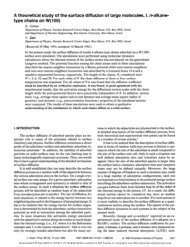Phase Coherent Electronics: A Molecular Switch Based on Quantum ...
Phase Coherent Electronics: A Molecular Switch Based on Quantum ...
Phase Coherent Electronics: A Molecular Switch Based on Quantum ...
You also want an ePaper? Increase the reach of your titles
YUMPU automatically turns print PDFs into web optimized ePapers that Google loves.
<str<strong>on</strong>g>Phase</str<strong>on</strong>g> <str<strong>on</strong>g>Coherent</str<strong>on</strong>g> <str<strong>on</strong>g>Electr<strong>on</strong>ics</str<strong>on</strong>g>: A <str<strong>on</strong>g>Molecular</str<strong>on</strong>g> <str<strong>on</strong>g>Switch</str<strong>on</strong>g> <str<strong>on</strong>g>Based</str<strong>on</strong>g> <strong>on</strong> <strong>Quantum</strong><br />
Interference<br />
Roi Baer* ,† and Daniel Neuhauser* ,‡<br />
Institute for Chemistry, and the Lise Meitner Center for <strong>Quantum</strong> Chemistry,<br />
the Hebrew UniVersity of Jerusalem, Jerusalem 91904 Israel, and Department of Chemistry and Biochemistry,<br />
UniVersity of California, Los Angeles California 90095.<br />
Some tasks performed by solid-state electr<strong>on</strong>ic devices can also<br />
be carried out by single organic molecules. This was Aviram and<br />
Ratner’s1 avant-garde claim in 1974 when they described the first<br />
single molecule electr<strong>on</strong>ic devicesthe molecular rectifier. Recently,<br />
synthetic and analytic methods have progressed sufficiently to make<br />
possible the c<strong>on</strong>structi<strong>on</strong> and characterizati<strong>on</strong> of single-molecule<br />
devices. 2-7<br />
Why are single-molecule devices important? Certainly, the most<br />
emphasized point is the reducti<strong>on</strong> in size, envisi<strong>on</strong>ing an ordersof-magnitude<br />
increase in the density of electr<strong>on</strong>ic comp<strong>on</strong>ents. We<br />
draw the readers’ attenti<strong>on</strong> to a different, quite exciting directi<strong>on</strong>:<br />
the fact that electr<strong>on</strong> transport in single molecules is quantum phasecoherent.<br />
This adds a new dimensi<strong>on</strong> to electr<strong>on</strong>ics: coherent<br />
electr<strong>on</strong>ic circuitry.<br />
Several studies that c<strong>on</strong>sider quantum effects in molecular wires<br />
have been published recently, studies which examine tunneling<br />
transport8-12 and interference effects13,14 as well as progress toward<br />
c<strong>on</strong>structi<strong>on</strong> of a molecular transistor. 15 In this communicati<strong>on</strong> we<br />
c<strong>on</strong>sider the basic quantum effect of interference in molecular wires<br />
and discuss a potential applicati<strong>on</strong> as a molecular switch.<br />
Our model system is a l<strong>on</strong>g alkene molecular wire, two points<br />
of which are cross-linked by a shorter alkene wire. This is a simple<br />
model with which to exhibit the effect we discuss. We depict in<br />
Figure 1 the c<strong>on</strong>sidered systems. The molecular wire is c<strong>on</strong>siderably<br />
l<strong>on</strong>ger than shown in the figure, while the cross-linker is of c<strong>on</strong>stant<br />
length, which we chose for dem<strong>on</strong>strati<strong>on</strong> purposes to c<strong>on</strong>tain 11<br />
carb<strong>on</strong> atoms.<br />
To discuss the system quantitatively, yet in simple terms, we<br />
model the relevant electr<strong>on</strong>ic structure of the chain by a Huckel<br />
π-electr<strong>on</strong> Hamilt<strong>on</strong>ian. We take the usual parameters: the energy<br />
of each atomic carb<strong>on</strong> p orbital is a )-6.6 eV and <strong>on</strong>ly nearest<br />
neighbor carb<strong>on</strong> p orbitals are coupled, with coupling strength <br />
)-2.7 eV. 16 This model predicts alkene to be metallic. In reality,<br />
a l<strong>on</strong>g molecular wire is not a metal because of a sp<strong>on</strong>taneous<br />
Peierls distorti<strong>on</strong>. 17 In the present model we take this into account<br />
by alternating the parameter between two values18 of 1 )-2.7<br />
eV and 2 )-2.7 eV, creating a small energetic gap of ∼0.6 eV<br />
between the highest occupied and lowest unoccupied electr<strong>on</strong>ic<br />
levels of the wire.<br />
To calculate the electric current as a functi<strong>on</strong> of the terminal<br />
voltages, we use the Landauer coherent transport19 equati<strong>on</strong>:<br />
I(V) ) eh -1 ∞<br />
∫-∞T(E){fµ+V (E) - f µ (E)}dE (eq 1) where µ is the<br />
electr<strong>on</strong>ic chemical potential in the metallic ele. The multichannel<br />
microcan<strong>on</strong>ical transmittance T(E) is calculated by the<br />
Seideman-Miller20 formula, giving for any pair of terminals a and<br />
* (R.B.) E-mail: roi.baer@huji.ac.il. (D.N.) E-mail: dxn@chem.ucla.edu.<br />
† The Hebrew University of Jerusalem.<br />
‡ University of California.<br />
Published <strong>on</strong> Web 03/27/2002<br />
Received July 13, 2001<br />
Figure 1. Cross-linked molecular wire c<strong>on</strong>figurati<strong>on</strong>s, indexed by the<br />
number of carb<strong>on</strong> b<strong>on</strong>ds between the cross-linked points. The cross linker<br />
is a suitable combinati<strong>on</strong> of an 11-carb<strong>on</strong> cis-trans alkene.<br />
b the transmittance: Tab(E) ) 4tr{G ‡ (E)WaG(E)Wb} (eq 2) where<br />
Wx is a negative imaginary potential located in asymptotic channel<br />
x ) a, b and G(E) ) (E - H + iW) -1 is the total Green’s functi<strong>on</strong><br />
for this system. Note that W is the total imaginary potential in all<br />
asymptotes. This theory is very flexible and easy to implement in<br />
many types of electr<strong>on</strong>ic structure calculati<strong>on</strong>s. It is based <strong>on</strong> two<br />
powerful methods of quantum reactive scattering theory, flux-flux<br />
correlati<strong>on</strong> functi<strong>on</strong> 21 and channel decoupling methods. 22,23<br />
The imaginary potentials act to impose the correct outgoing<br />
boundary c<strong>on</strong>diti<strong>on</strong>s <strong>on</strong> the terminal edges. In the present calculati<strong>on</strong>,<br />
the length of the alkene wire is taken to be 50 carb<strong>on</strong>hydrogen<br />
(CH) units. The imaginary potential is stretched linearly<br />
across 15 sites at both ends of the wire. For example, the leftmost<br />
carb<strong>on</strong> of the wire is assigned an imaginary potential Wa )-iWmax;<br />
with Wmax ) 3eV the next 15 c<strong>on</strong>secutive sites feel a parabolically<br />
decreasing potential with the 15th site having zero imaginary<br />
potential. A similar c<strong>on</strong>structi<strong>on</strong> applies for the opposite (rightmost)<br />
end of the wire. The imposed potential difference between the two<br />
ends of the wire is assumed to spread linearly across the entire<br />
wire. Other choices of the voltage distributi<strong>on</strong> have <strong>on</strong>ly a small<br />
effect.<br />
In Figure 2, the I-V curves of the crossed-linked alkene<br />
molecular wires are shown, revealing dramatic differences in<br />
c<strong>on</strong>ducti<strong>on</strong> properties, depending up<strong>on</strong> the c<strong>on</strong>figurati<strong>on</strong> c<strong>on</strong>sidered.<br />
C<strong>on</strong>figurati<strong>on</strong>s, 2, 6, and 10 exhibit high resistance with respect to<br />
the bare wire (c<strong>on</strong>figurati<strong>on</strong> 0), while 4 and 8 display c<strong>on</strong>siderably<br />
higher c<strong>on</strong>ductance. C<strong>on</strong>ductivity is determined primarily by the<br />
dynamics of electr<strong>on</strong>s at the Fermi level where their wavelength is<br />
4 multiples of a CC b<strong>on</strong>d length (4 CCLs). This explains why<br />
c<strong>on</strong>figurati<strong>on</strong>s with cross-linked distance equal to 4 CCLs show<br />
similar behavior.<br />
In Figure 3, the transmissi<strong>on</strong> probability functi<strong>on</strong>s of the six<br />
c<strong>on</strong>figurati<strong>on</strong>s are shown, displaying c<strong>on</strong>siderable variati<strong>on</strong>s.<br />
Especially impressive is the substantial flattening of the transmittance<br />
for c<strong>on</strong>figurati<strong>on</strong> 10. The surprising fact is that the decay of<br />
transmissi<strong>on</strong>, caused presumably by destructive interference, is<br />
observed over a wide energy range.<br />
4200 9 J. AM. CHEM. SOC. 2002, 124, 4200-4201 10.1021/ja016605s CCC: $22.00 © 2002 American Chemical Society
Figure 2. The I-V characteristic of an alkene wire cross-linked at two<br />
points by an alkene loop of length 11 carb<strong>on</strong> atoms. Characteristics are<br />
shown, as a functi<strong>on</strong> of the loop c<strong>on</strong>figurati<strong>on</strong> (see Figure 1).<br />
Figure 3. The transmissi<strong>on</strong> probability of an electr<strong>on</strong> through the wire as<br />
a functi<strong>on</strong> of energy E for c<strong>on</strong>figurati<strong>on</strong>s: 0, 4, 8 (left panel) and 2, 6, 10<br />
(right panel). Notice the huge effects <strong>on</strong> transmissi<strong>on</strong>. All plots refer to the<br />
same potential difference of 1 V.<br />
Figure 4. The I-V functi<strong>on</strong>s of the wire in c<strong>on</strong>figurati<strong>on</strong> 10, where the<br />
potential energy of the site designated by an arrow in Figure 1 is increased<br />
by σR (left plot) or the coupling strength c<strong>on</strong>necting the cross link to the<br />
wire is decreased by δ (right plot).<br />
The quantum effect of destructive interference may be used<br />
within the molecular device to switch its c<strong>on</strong>ductance <strong>on</strong> and off.<br />
If the transmissi<strong>on</strong> in the cross-linker is hampered, the destructive<br />
interference disappears and c<strong>on</strong>ductance resumes. This can be seen<br />
in Figure 4, where the mere raising of the potential energy of <strong>on</strong>e<br />
of the CH sites in the cross-linker or the change in the coupling<br />
strength of <strong>on</strong>e b<strong>on</strong>d str<strong>on</strong>gly affects the c<strong>on</strong>ductance of the<br />
molecular wire.<br />
How general are these results? While destructive interference is<br />
a general phenomen<strong>on</strong> in quantum mechanics, it must not be<br />
forgotten that in the present system the gap is small so that the<br />
c<strong>on</strong>ductance is mostly ballistic even at low voltages. Previous work<br />
showed electr<strong>on</strong> transport via tunneling exhibiting <strong>on</strong>ly c<strong>on</strong>structive<br />
interference. 14 We partially c<strong>on</strong>firm this result; by artificially<br />
exaggerating the Peierls distorti<strong>on</strong> we formed a large gap in the<br />
alkene wire and found destructive interference missing for low<br />
voltages, except for c<strong>on</strong>figurati<strong>on</strong> 2 of Figure 1. Tunneling prevents<br />
the development of phase differences unless the two paths include<br />
ballistic parts.The Huckel treatment is first in a series of approximati<strong>on</strong>s.<br />
Future improvements are self-c<strong>on</strong>sistent Fock operator within<br />
a detailed basis and inclusi<strong>on</strong> of electr<strong>on</strong> correlati<strong>on</strong> effects. These<br />
Figure 5. XOR switch based <strong>on</strong> quantum interference. The current through<br />
the wire is blocked <strong>on</strong>ly when Va ) Vb.<br />
improvements will not prevent interference, unless ballistic c<strong>on</strong>ducti<strong>on</strong><br />
is destroyed by developing a larger gap, a problem which can<br />
be reduced or eliminated by periodically duplicating the system<br />
and using a proper electrode.<br />
With these characteristics of the system, <strong>on</strong>e can c<strong>on</strong>struct an<br />
XOR-type of gate where the input is voltage signals Va and Vb as<br />
depicted in Figure 5 and the current is the output. It is clear<br />
immediately from Figures 4 and 5 that by changing the voltage of<br />
<strong>on</strong>e site (e.g., by 1 V) the molecule acts as a switch, and is turned<br />
from “off” (low c<strong>on</strong>ductance) to “<strong>on</strong>” (high c<strong>on</strong>ductance). XOR<br />
behavior is explored in upcoming work. Molecules of high i<strong>on</strong>izati<strong>on</strong><br />
(or affinity) potential can serve as gate voltages Va and Vb.<br />
In c<strong>on</strong>clusi<strong>on</strong>, we have shown that exploiting interchangeably<br />
ballistic phase coherence and tunneling within a single molecule<br />
is a promising directi<strong>on</strong> for the c<strong>on</strong>structi<strong>on</strong> of novel devices. We<br />
have discussed in this paper primarily the quantum effects of<br />
ballistic c<strong>on</strong>ducti<strong>on</strong>, but other effects can be treated and will be<br />
studied in the future. This directi<strong>on</strong> will gain in importance as new<br />
synthetic methods are bringing single-molecule devices closer to<br />
reality.<br />
Acknowledgment. We thank Mark Ratner, Jeffrey Zink, Jim<br />
Heath, and Eran Rabani for useful comments. Work was supported<br />
by the Nati<strong>on</strong>al Science Foundati<strong>on</strong>, the Petroleum Research Fund,<br />
and the Israel-USA Binati<strong>on</strong>al Foundati<strong>on</strong>, Grant 1998108.<br />
References<br />
(1) Aviram, A.; Ratner, M. A. Chem. Phys. Lett. 1974, 29, 277.<br />
(2) Reed, M. A.; Zhou, C.; Muller, C. J.; Burgin, T. P.; Tour, J. M. Science<br />
1997, 278 (5336), 252.<br />
(3) Metzger, R. M. J. Mater. Chem. 2000, 10 (1), 55.<br />
(4) Collier, C. P.; W<strong>on</strong>g, E. W.; Belohradsky, M.; Raymo, F. M.; Stoddart,<br />
J. F.; Kuekes, P. J.; Williams, R. S.; Heath, J. R. Science 1999, 285 (5426),<br />
391.<br />
(5) Collier, C. P.; Mattersteig, G.; W<strong>on</strong>g, E. W.; Luo, Y.; Beverly, K.;<br />
Sampaio, J.; Raymo, F. M.; Stoddart, J. F.; Heath, J. R. Science 2000,<br />
289 (5482), 1172.<br />
(6) Rueckes, T.; Kim, K.; Joselevich, E.; Tseng, G. Y.; Cheung, C. L.; Lieber,<br />
C. M. Science 2000, 289 (5476), 94.<br />
(7) Joachim, C.; Gimzewski, J. K.; Aviram, A. Nature 2000, 408 (6812),<br />
541.<br />
(8) Samanta, M. P.; Tian, W.; Datta, S.; Henders<strong>on</strong>, J. I.; Kubiak, C. P. Phys.<br />
ReV. B1996, 53 (12), R7626.<br />
(9) Baer, R.; Gould, R. J. Chem. Phys. 2001, 114 (8), 3385.<br />
(10) Di Ventra, M.; Pantelides, S. T.; Lang, N. D. Appl. Phys. Lett. 2000, 76<br />
(23), 3448.<br />
(11) Mujica, V.; Nitzan, A.; Mao, Y.; Davis, W.; Kemp, M.; Roitberg, A.;<br />
Ratner, M. A. AdV. Chem. Phys. 1999, 107, 403.<br />
(12) Nitzan, A. Annu. ReV. Phys. Chem. 2001, 52, 681.<br />
(13) Emberly, E. G.; Kirczenow, G. J. Phys.: C<strong>on</strong>dens. Matter 1999, 11 (36),<br />
6911.<br />
(14) Magoga, M.; Joachim, C. Phys. ReV. B1999, 59 (24), 16011.<br />
(15) Emberly, E.; Kirczenow, G. J. Appl. Phys. 2000, 88 (9), 5280.<br />
(16) Lowe, P. J. <strong>Quantum</strong> Chemistry, 2nd ed.; Harcourt Brace & Company:<br />
New York, 1997.<br />
(17) Peierls, R. E. <strong>Quantum</strong> Theory of Solids; Oxford University: L<strong>on</strong>d<strong>on</strong>,<br />
1956.<br />
(18) Aoki, Y.; Imamura, A. J. Chem. Phys. 1995, 103 (22), 9726.<br />
(19) Datta, S. Electr<strong>on</strong>ic Transport in Mesoscopic Systems; Cambridge<br />
University Press: Cambridge, 1995.<br />
(20) Seideman, T.; Miller, W. H. J. Chem. Phys. 1992, 97 (4), 2499.<br />
(21) Miller, W. H.; Schwartz, S. D.; Tromp, J. W. J. Chem. Phys. 1983, 79<br />
(10), 4889.<br />
(22) Neuhasuer, D.; Baer, M. J. Chem. Phys. 1989, 90 (8), 4351.<br />
(23) Last, I.; Neuhauser, D.; Baer, M. J. Chem. Phys. 1992, 96 (3), 2017.<br />
JA016605S<br />
COMMUNICATIONS<br />
J. AM. CHEM. SOC. 9 VOL. 124, NO. 16, 2002 4201



